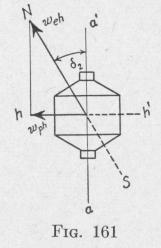In order that the gyro-compass may remain in equilibrium,
the resting position of the gyro-axle, aa', Fig. 161, must make an
angle 52 with the meridian plane NS such that the component wph of the precessional velocity of the spin-axle about a horizontal axis hh' perpendicular to the spin-axle, will equal the component of the earth's rotation with respect to the same axis. In Figs. 159 and 161, the horizontal component in the meridian plane of the angular velocity of the earth is represented by welt. Thus, we wish to have
From Fig. 159
From these last two equations and (128) we can eliminate welt,
wph and wej and obtain
For all compasses designed for the same angle 0, tan 0 is a constant. If 32 be small, we may replace sin 62 by 52. Under these conditions, the correction of a Sperry compass due to latitude has the value
where b represents the constant tan 0. This correction must be added to or subtracted from the compass reading, depending upon whether 0 is positive or negative and whether the compass is north or south of the equator. In northern latitudes the deflection is east of the meridian; in southern latitudes it is west of the meridian. At latitude 50°, the latitude error is about 2°.
123. Correction Mechanism for Velocity and Latitude Errors. - The compass card is surrounded by a coplanar ring called the " lubber ring " on which is engraved a line called the " lubber line " parallel to the keel of the ship. If the spin-axle is in the meridian plane, the angle between the N-S line of the compass
THE SPERRY GYRO-COMPASS 207
card and the lubber line gives the direction of the ship. The cards of gyro-compasses are marked in degrees, from 0 to 360.
A person could tell the correct time from the reading of a clock known to be five minutes fast by subtracting from the observed reading the five-minute error. He could tell the correct time without the necessity of keeping the error in mind if the clock face were rotated through 30 degrees in the clockwise direction about the spindle which carries the two hands. This procedure might not be regarded as correcting the clock error but it would at any rate make the clock indicate the correct time. In a similar manner the meridian-steaming error and the latitude error of the Sperry gyro-compass are allowed for automatically by a shift of the lubber line.
The total deviation of the gyro-axle from the meridian due to the meridian-steaming error together with the latitude error is (119 and 129):
where a and b are easily determined constants, v is the speed of the ship in knots, 0 is the course measured in degrees from the meridian and X is the latitude. The first term in the right-hand member of (130) results in an eastward deflection of the northseeking end of the spin-axle when the ship is steaming southward and a westward deflection when steaming northward. The second term results in an eastward deflection when the ship is in northern latitudes and a westward deflection when in southern latitudes.
The device used on the Sperry gyro-compass consists of two dials, a cam and a system of rods that maintain the proper shift of the lubber line after the dials have been set for the latitude and speed of the ship. Figure 162 is a diagram of the device that is used on compasses of the models designated Mark II and Mark V. The lubber ring X is turned relative to the compass card Y by the system connected to the pin Z. The course-corrector ring R is fastened rigidly to the phantom and consequently remains in constant relation to the gyro-axle of the compass. Its plane is inclined to the horizontal plane. The east-and-west diameter of the ring is horizontal. The higher side of the ring is directly above the north-seeking end of the gyro-axle of the compass. A roller C on one end of the rod AC engages in a groove in the edge of the ring. The end A of the rod AC and the two dials Dl and

